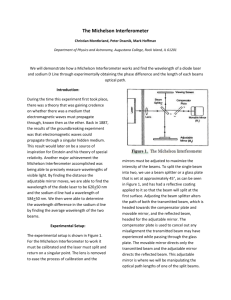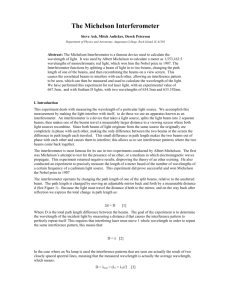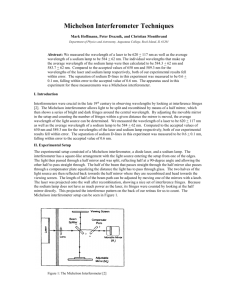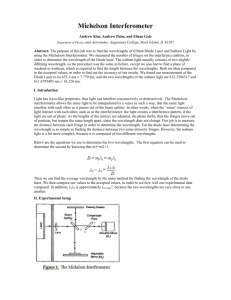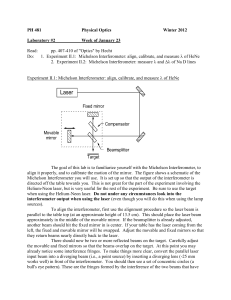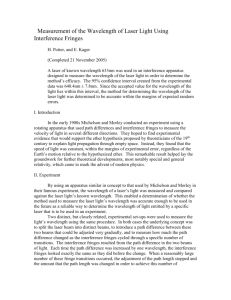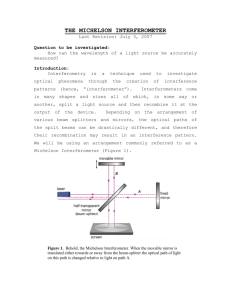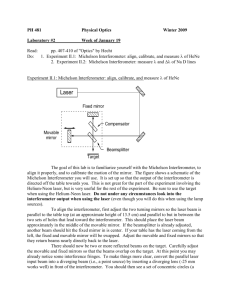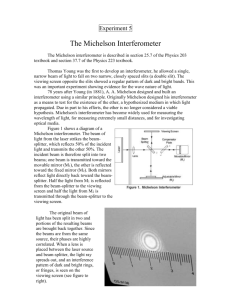Michelson Interferometer: Wavelength Measurement Lab
advertisement
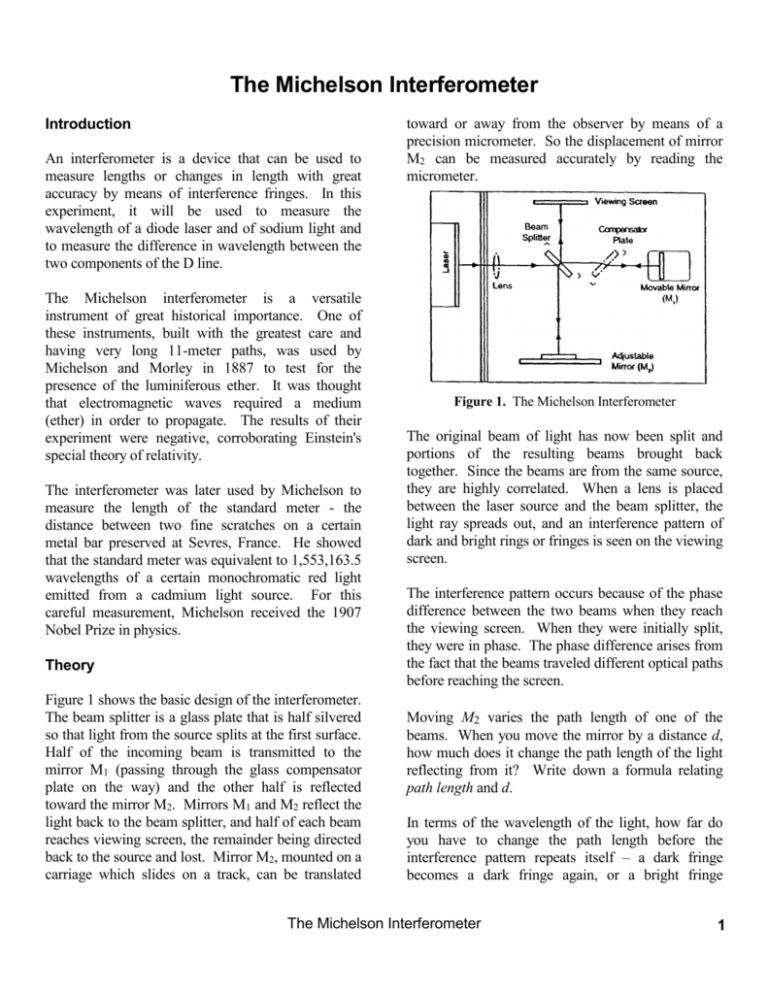
The Michelson Interferometer Introduction An interferometer is a device that can be used to measure lengths or changes in length with great accuracy by means of interference fringes. In this experiment, it will be used to measure the wavelength of a diode laser and of sodium light and to measure the difference in wavelength between the two components of the D line. The Michelson interferometer is a versatile instrument of great historical importance. One of these instruments, built with the greatest care and having very long 11-meter paths, was used by Michelson and Morley in 1887 to test for the presence of the luminiferous ether. It was thought that electromagnetic waves required a medium (ether) in order to propagate. The results of their experiment were negative, corroborating Einstein's special theory of relativity. The interferometer was later used by Michelson to measure the length of the standard meter - the distance between two fine scratches on a certain metal bar preserved at Sevres, France. He showed that the standard meter was equivalent to 1,553,163.5 wavelengths of a certain monochromatic red light emitted from a cadmium light source. For this careful measurement, Michelson received the 1907 Nobel Prize in physics. Theory Figure 1 shows the basic design of the interferometer. The beam splitter is a glass plate that is half silvered so that light from the source splits at the first surface. Half of the incoming beam is transmitted to the mirror M1 (passing through the glass compensator plate on the way) and the other half is reflected toward the mirror M2. Mirrors M1 and M2 reflect the light back to the beam splitter, and half of each beam reaches viewing screen, the remainder being directed back to the source and lost. Mirror M2, mounted on a carriage which slides on a track, can be translated toward or away from the observer by means of a precision micrometer. So the displacement of mirror M2 can be measured accurately by reading the micrometer. Figure 1. The Michelson Interferometer The original beam of light has now been split and portions of the resulting beams brought back together. Since the beams are from the same source, they are highly correlated. When a lens is placed between the laser source and the beam splitter, the light ray spreads out, and an interference pattern of dark and bright rings or fringes is seen on the viewing screen. The interference pattern occurs because of the phase difference between the two beams when they reach the viewing screen. When they were initially split, they were in phase. The phase difference arises from the fact that the beams traveled different optical paths before reaching the screen. Moving M2 varies the path length of one of the beams. When you move the mirror by a distance d, how much does it change the path length of the light reflecting from it? Write down a formula relating path length and d. In terms of the wavelength of the light, how far do you have to change the path length before the interference pattern repeats itself – a dark fringe becomes a dark fringe again, or a bright fringe The Michelson Interferometer 1 becomes bright again? Write down a formula relating path length and. After answering these questions, you can determine the wavelength of a source by finding the average distance, d, that you move the mirror to get a repeat in the pattern of fringes. Write down a formula relating d and . C. Wavelength of Sodium D Lines. When the sodium source is used, it is important that the optical paths of the two interfering beams should be nearly equal. Make sure that you have adjusted the setup with the laser to get fringes that are wellseparated, before replacing the laser with the sodium light source. Measurements A. Alignment of the Interferometer. Adjust the laser beam so that it is approximately parallel with the top of the base. The beam should strike the center of the movable mirror (M1) and be reflected back into the laser aperture. Position the beam-splitter at a 45-degree angle to the laser beam, within the crop marks, so that the beam is reflected to the adjustable mirror (M2). Adjust the angle of the beam-splitter so that the reflected beam hits M2 near its center. There should now be two sets of bright dots on the viewing screen; one set comes from M1 and the other from M2 . Each set of dots should include a bright dot with two or more dots of lesser brightness due to multiple reflections. Adjust the angle of the beam-splitter again until the two sets of dots are as close together as possible, then tighten the thumbscrew to secure the beam-splitter. Using the thumbscrews on the back of M2, adjust the mirror’s tilt until the two sets of dots on the viewing screen coincide. B. Wavelength of Diode Laser. The laser light is bright enough to project the interference pattern onto the screen, using a converging lens. Adjust so you can see circular fringes in the diverging beam. Further adjustment of the moveable mirror and the adjustable mirror may be necessary to get circular fringes that are not too closely spaced. 2 Determine the average distance that you move the mirror to get a repeat in the pattern of fringes, and from this, determine the wavelength of the laser light. (Make sure your answer makes sense.) . The sodium source is not intense enough to project on the screen, so remove the converging lens. Instead you will use the converging lens of your eye to project directly on your retina – that is, you will look directly into the apparatus to see the fringes. Again, determine the average distance that you move the mirror to get a repeat in the pattern of fringes, and from this, determine the wavelength of the laser light. (Make sure your answer makes sense.) Note that the observed sodium line is actually the sum of two closely spaced spectral lines, the value for wavelength determined here is the average value of the two sodium D lines. C. Measurement of Wavelength Difference The wavelength difference between two close lines such as the components of the sodium D line is determined from their average wavelength and the visibility of the fringes. When of the sodium D lines are in phase together, the fringes of clear and sharp. When one line is in phase at a point where the other is out of phase and vice versa, the fringes are washed out and indistinct. If you find a position where the fringes are most (or least) clear, you can scroll through several fringes to find a spot where they are most (or least) clear again. This distance is an integer number of fringes for both of the sodium D-lines. The Michelson Interferometer D = m1d1 = m2 d 2 . (2) For the distances to be equal, the shorter wavelength 1 gives rise to more fringes than the longer one. How many more? Using this concept and your previous equation for the distance between fringes as a function of wavelength, show that the difference between the 2 sodium D-line wavelengths is given by 2 1 . (2) 2 1 = 2D In order to obtain a good value of the wavelength difference, you should make several measurements of the distance, D, between adjacent visibility minima. Calculate the wavelength difference and each individual wavelength from your data and compare them to the standard values. The Michelson Interferometer 3
